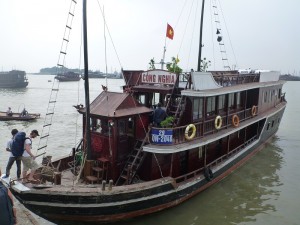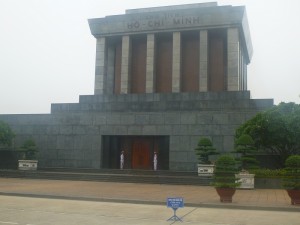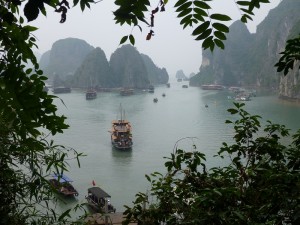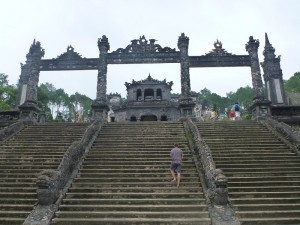Right behind the border we are joined by a group of motor bikers who offer us transport but for an enormous price. Although there is another guy with a van, who would be willing to take us, these guys just shout something at him and make him leave. Nice welcome. We go to the parking place full of buses and minibuses. Even though the offer is much higher than demand, the color of our skin doesn’t give us too much space for negotiation. All drivers just laugh st us when we try to reduce the exaggerated price just by a few dongs. In the end we have no other choice than to give up and pay more than the Vietnamese for the 200km long drive to Hanoi. Still though, it is just some 90CZK.
We get off in the Old district – historical center of the city, northwards from the Hoan Kiem lake. Unbelievable chaos and constant horning of motorbikes disappears only during few hours in the middle of the night. No matter whether you like it here or not, in terms of atmosphere there is hardly anything else in Vietnam that it could be compared to. However, apart from one mausoleum, two or three museums and an old district with nearby lakes, there is hardly anything worth seeing. We take it more like an opportunity to adapt to the local never-ending chaos and noise – two features of Vietnam that maybe only the Indian nations can compete with.
Our next stop is one of the 7 world‘s wonders of nature, the Ha Long bay. We choose a three-day long trip with first night spent on a boat and second on the Cat Ba Island. Tours to Ha Long are famous for the various methods and tricks of getting the most money from the tourists with as little effort as possible. Immediately upon boarding the ship it is obvious what is „in“ right now. It is prohibited to take anything to drink on board, even non-alcoholic. And of course, the prices for beverages are in comparison to the rest of Vietnam, astronomical. Fortunately, when the ship stops some woman in a small boat full of drinks comes close. We change to swimming suits and jump into the water. The seamen just angrily watch us taking the opportunity of making an improvised bar in the middle of the see and enjoying the sunset in Ha Long bay from an unusual perspective.
After returning from Ha Long we spend one more night in Hanoi and then travel further by a train across half of Vietnam to the former imperial city of Hue. The city center of Hue is dominated by a nice imperial palace and fortress in front of which one can see the largest Vietnamese flag in the country. A few imperial burial chambers are scattered around and are definitely worth seeing. Our next stop in Hue is the demilitarized zone between north and south. The most interesting bit is the tunnels which were used as a shelter for an entire village during bombardments. Kilometers of narrow corridors and small recesses, even a delivery room. Sometimes the locals lived here for many months to protect themselves from the common bombardments.
Next stop on our south-north journey is Hoi-An. Today it is a small town and a conservation area. During this time of the year the heavy rains cause the local river to flood all the nearby streets. It is interesting to watch how motorbikes and bikes are gradually replaced by boats as the height of the water in the streets increases. Due to the flooding we are not even able to get to the mountain station Ba Na, or more specifically to the cable car which would take us there.
The persisting rain and floods make us change our original plans of going further south to the beaches near Mui Ne. The connection between north and south of the country is interrupted and the only possibility of getting there is by a plane. Because the situation doesn’t get any better during the next three days we change our route plan. Instead of a journey along the coast we get a van and go towards the Laos border to the city of Kon Tum. Kon Tum seems more Vietnamese than any other city we have seen so far. No wonder. It is away from all the major routes, and tourists are very rare. While guys try to get information about going to the mountain villages, I try to get tickets for a bus to Laotian Pakse. However, neither of us is successful. The bus leaves just the moment I get there and the price of eco tours to the mountains is so high that we resign and say bye to discovering the surroundings. Instead we go to a buffet near the bus station and order our last Vietnamese meal, a beer and play cards. In the afternoon, guys get on a night bus to the Da Lat mountain resort while I stay until the next morning and then go via Laos and Thailand to Malaysian Kuala Lumpur. Our group divides for the first time since the Mongolian Ulaanbaatar. If everything goes as planned, we will meet again in three weeks in Malaysia…









